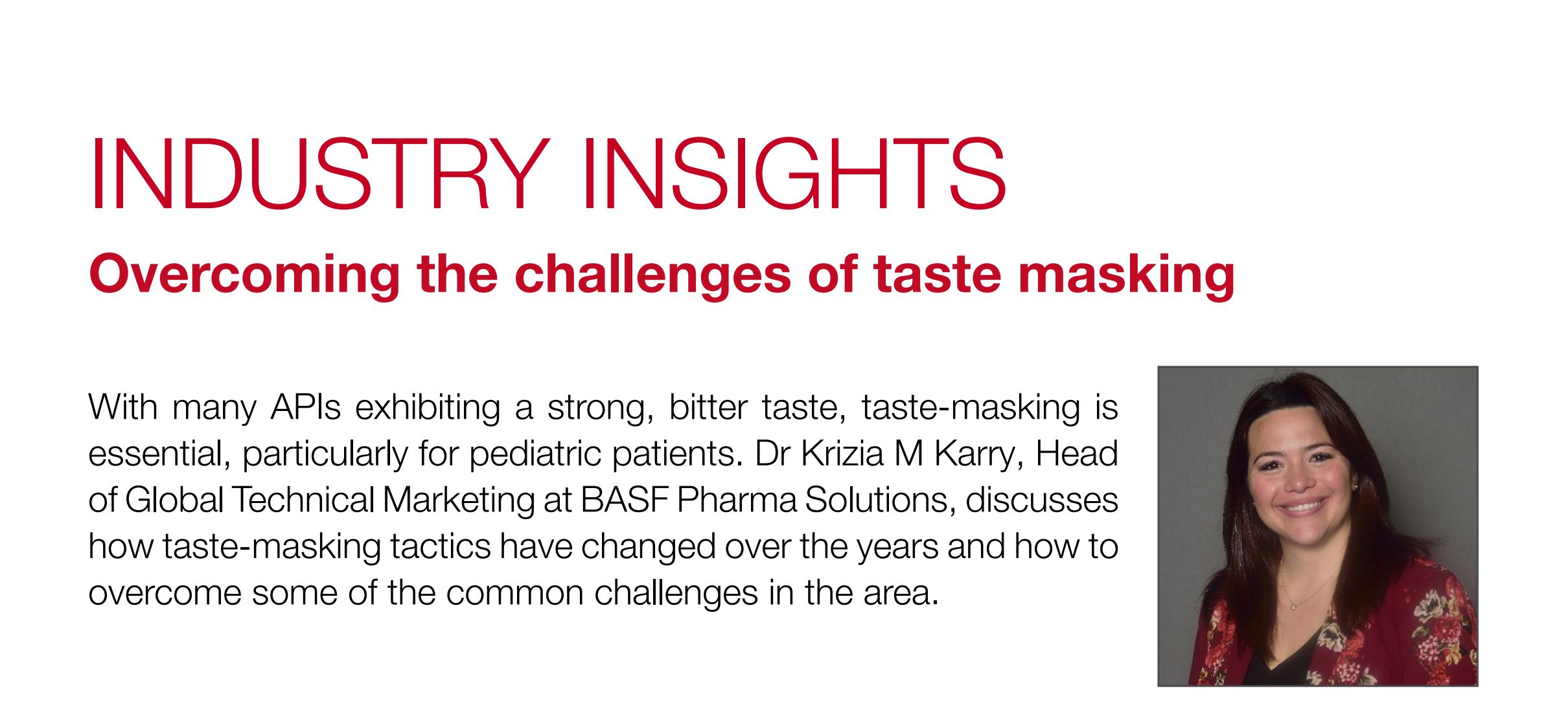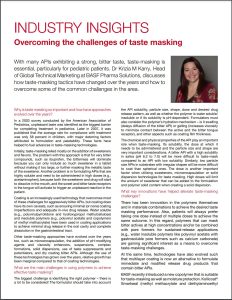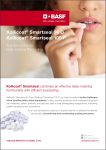Overcoming Challenges of Taste Masking

In a 2003 survey conducted by the American Association of Pediatrics, unpleasant taste was identified as the most significant barrier to completing treatment in pediatrics.
Drug taste masking is extremely relevant to improve patient convenience and compliance. It’s currently a relevant consideration to formulators since almost 66% of current experimental and clinical drugs are classified as bitter, and most aren’t aware of that.¹
To address this issue, BitterDB is a virtual tool that can be used for drug taste evaluation using the system database with more than 1000 molecules and receptors.²
Learn how to achieve taste masking: In this interview, Krizia M. Karry, PhD shares insights and an overview of available technologies and formulation approaches to overcome palatability challenges.
Read the full interview below!
Learn more about BitterDB at https://www.ncbi.nlm.nih.gov/pmc/articles/PMC6323989/
1 -𝘋𝘢𝘨𝘢𝘯-𝘞𝘪𝘦𝘯𝘦𝘳 𝘈, 𝘕𝘪𝘴𝘴𝘪𝘮 𝘐, 𝘉𝘦𝘯 𝘈𝘣𝘶 𝘕, 𝘉𝘰𝘳𝘨𝘰𝘯𝘰𝘷𝘰 𝘎, 𝘉𝘢𝘴𝘴𝘰𝘭𝘪 𝘈, 𝘕𝘪𝘷 𝘔𝘠. 𝘉𝘪𝘵𝘵𝘦𝘳 𝘰𝘳 𝘯𝘰𝘵? 𝘉𝘪𝘵𝘵𝘦𝘳𝘗𝘳𝘦𝘥𝘪𝘤𝘵, 𝘢 𝘵𝘰𝘰𝘭 𝘧𝘰𝘳 𝘱𝘳𝘦𝘥𝘪𝘤𝘵𝘪𝘯𝘨 𝘵𝘢𝘴𝘵𝘦𝘧𝘳𝘰𝘮 𝘤𝘩𝘦𝘮𝘪𝘤𝘢𝘭 𝘴𝘵𝘳𝘶𝘤𝘵𝘶𝘳𝘦. 𝘚𝘤𝘪 𝘙𝘦𝘱. 𝘚𝘦𝘱𝘵𝘦𝘮𝘣𝘦𝘳 2017
2 – 𝘞𝘪𝘦𝘯𝘦𝘳 𝘈, 𝘚𝘩𝘶𝘥𝘭𝘦𝘳 𝘔, 𝘓𝘦𝘷𝘪𝘵 𝘈, 𝘕𝘪𝘷 𝘔𝘠. 𝘉𝘪𝘵𝘵𝘦𝘳𝘋𝘉: 𝘢 𝘥𝘢𝘵𝘢𝘣𝘢𝘴𝘦 𝘰𝘧 𝘣𝘪𝘵𝘵𝘦𝘳 𝘤𝘰𝘮𝘱𝘰𝘶𝘯𝘥𝘴. 𝘕𝘶𝘤𝘭𝘦𝘪𝘤 𝘈𝘤𝘪𝘥𝘴 𝘙𝘦𝘴𝘦𝘢𝘳𝘤𝘩. 𝘑𝘢𝘯𝘶𝘢𝘳𝘺 2012
The interview:
“INDUSTRY INSIGHTS – Overcoming Challenges of Taste Masking”
With many APIs exhibiting a strong, bitter taste, taste-masking is essential, particularly for pediatric patients. Dr Krizia M Karry, Head of Global Technical Marketing at BASF Pharma Solutions, discusses how taste-masking tactics have changed over the years and how to overcome some of the common challenges in the area.
Why is taste masking so important and how have approaches evolved over the years?
In a 2003 survey conducted by the American Association of Pediatrics, unpleasant taste was identified as the biggest barrier for completing treatment in pediatrics. Later in 2007, it was published that the average rate for compliance with treatment was only 58 percent in children, with major deterring factors attributed to formulation and palatability. These facts have helped to fuel advances in taste-masking technologies. Initially, taste-masking relied mostly on the addition of sweeteners and flavors. The problem with this approach is that for very bitter compounds, such as ibuprofen, the bitterness will dominate because you can only include so much sweetener in a tablet without making it too large, or further masking the metallic taste of the sweetener. Another problem is in formulating APIs that are highly soluble and need to be administered in high doses (e.g., acetaminophen), because both the sweetener and drug will start to dissolve in the mouth, and the sweet and bitter taste receptors in the tongue will activate to trigger an unpleasant reaction in the patient.
Coating is an increasingly used technology that overcomes most of these challenges for aggressively bitter APIs, but coating does have its own caveats, such as ensuring minimal (or none) coating imperfections and adequate in-vivo drug release. Water soluble (e.g., polyvinylpyrrolidone and hydroxypropyl methylcellulose) and insoluble polymers (e.g., polyvinyl acetate and copolymers of methyl methacrylate) have been used in coating applications to achieve minimal drug release in the oral cavity and complete dissolution in the gastrointestinal tract.
Other taste-masking approaches have evolved over the years too, such as microencapsulation, the addition of pH-modifying agents and viscosity enhancers, suspensions, complex formations, solid dispersions, use of taste suppressants and potentiators, and dry coating bitter APIs. Although the use of these technologies has grown over the years, relative growth has been marginal compared to that of coating technologies.
What are the main challenges in using polymers to achieve effective taste masking?
The biggest challenge is identifying the right polymer – there is a lot to be considered! The formulator should take into account the API solubility, particle size, shape, dose and desired drug release pattern, as well as whether the polymer is water soluble/ insoluble or if its solubility is pH-dependent. Formulators must also consider the polymer’s hydration mechanism – is it swelling (delays diffusion of the bitter API) or gelling (increases viscosity to minimize contact between the active and the bitter tongue receptor), and other aspects such as coating film thickness. The chemical and physical properties of the API play an important role when taste-masking. Its solubility, the dose at which it needs to be administered and the particle size and shape are very important considerations. A bitter API with a high solubility in saliva (pH 6.2 to 7.0) will be more difficult to taste-mask compared to an API with low solubility. Similarly, low particle
size APIs in substrates with irregular shapes will be more difficult to coat than spherical ones. The dose is another important factor when utilizing sweeteners, microencapsulation or solid dispersion technologies for taste masking. High doses will limit the amount of sweetener that can be added to the formulation and polymer solid content when creating a solid dispersion.
What key innovations have helped alleviate taste-masking challenges?
There has been innovation in the polymers themselves and in materials combinations to achieve the desired taste masking performance. Also, patients will always prefer taking one dose instead of multiple doses to achieve the
same outcome. In this regard, polymers that can mask bitter actives at high concentrations and/or be combinedwith pore formers for sustained-release applications (e.g., water insoluble polymers like polyvinyl acetate with gastrosoluble pore formers such as calcium carbonate) are gaining significant interest as a means to overcome taste-masking challenges. At the same time, technologies have also evolved such that multilayer coating is now an alternative to formulate immediate and modified release drug products that contain bitter APIs. BASF recently introduced a new copolymer that is suitable for taste-masking as well as moisture protection. Kollicoat® Smartseal (methyl methacrylate and diethylaminoethylmethacrylate) is a film-forming polymer designed to be insoluble at typical saliva pH for efficient taste masking, but completely and immediately soluble in gastric (stomach) media at pH < 5.5. The polymer is available as an aqueous dispersion (Kollicoat® Smartseal 30 D) and as a powder (Kollicoat® Smartseal 100 P), which can either be redispersed in water or dissolved in organic solvents.
An additional consideration when selecting for the right polymer for taste-masking, is the material’s cost-of-use. This includes taking into account any additional excipient that needs to be added to the formulation for the tastemasking to be effective, processing steps and times, current containment and safety measures, among others. In this case, Kollicoat® Smartseal outperforms all others because it was designed with the end-user in mind. The polymer is manufacturing site friendly because its processing is safe (does not require the addition of strong acids or harsh surfactants), it has a great smell, and it efficiently masks taste even at very low coating levels, which translates to material savings and process time reductions.
Download and read the full interview as PDF “Overcoming the challenges of taste masking” here:
(click on the picture below)
Source: BASF, interview “Overcoming the challenges of taste masking”
Do you need more information or a sample of excipients by BASF?
Read also the further taste-masking article:



